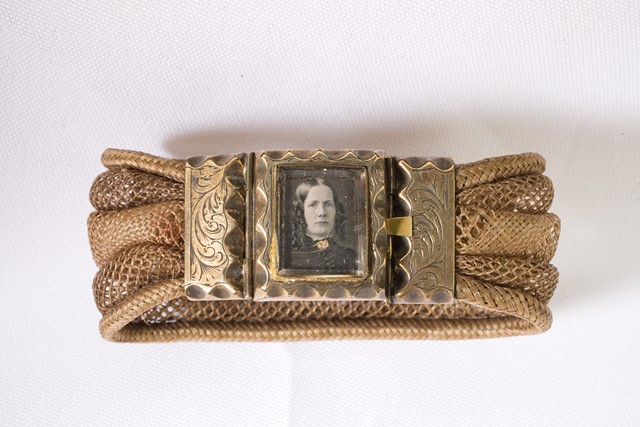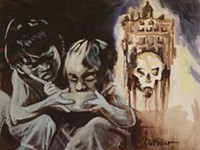[
{
"name": "500x250 Ad",
"insertPoint": "5",
"component": "15667920",
"parentWrapperClass": "",
"requiredCountToDisplay": "1"
}
]
Death is a common theme in art, though its presence isn’t always obvious. But meditations on mortality and remembrance are the subject of innocuous-seeming artworks everywhere. Like paintings of beautiful young women admiring their own reflections — but if you squint, the whole scene becomes a skull. Or a lush still life of vibrant, over-ripe fruit and flowers — but there in the corner is a moth floating on a doom-trajectory toward a flame. Or an hourglass, or a candle nearly burned out. A beautiful bracelet of intricately woven brown strands which turn out to be the hair of a departed family member. And so on.
Rochester’s art institutions are rife with these kinds of works, and some of them are on display this month.
At the Memorial Art Gallery, Curator of American Art Jessica Marten said some works currently on view in the MAG’s 19th-century gallery fit the bill. Take Rochester artist Helen Searle’s 1871 painting “Still Life with Goblet and Fruit.” Set on a pristine white cloth, globes of ripe peaches, plums, and grapes are swollen with juices, their forms reflected in and by the curve of a green goblet filled with some unknown elixir — picture satyrs and nymphs blissfully cavorting off-frame. But this Dionysian celebration of the deliciousness of life is adulterated by the tiniest allusion to rot, with Searle’s inclusion of a single black fly, which the curatorial text states is a symbol of death, decay, and a reminder of the brevity of life. It’s subtle, but nagging and ruinous.
This showcase includes many similar works — pictures of vibrant abundance with small visual reminders that death awaits — as well as James Carroll Beckwith’s entirely unsubtle 1878 painting, “Fame.” He painted a simple scene: a skull with its mouth eternally agape in laughter or awe, surrounded by a void of subdued hues and wearing a crown of laurels. A stark and straight-to-the-point work, asking when even legacy is as fragile as a shivering leaf, what remains but our remains?
The George Eastman Museum collection also includes artworks about death and bereavement, including many photographs of the dead. It may seem morbid today, but it was once a fairly common practice to have a photograph taken of or with someone who had recently departed.
Notably, Eastman also has some Victorian mourning jewelry — intricately knotted weavings from the hair of a loved one. In one particular item from 1850, a bracelet made from hair includes a charm, a small Daguerreotype image of the departed.
See this item and more in Eastman’s newest iteration of the ongoing “Selections from the Collection,” which was refreshed at Eastman’s Collection Gallery in late September.
Rebecca Rafferty is an arts writer at CITY and the co-producer and host of art/WORK, an arts conversation video series created in collaboration with WXXI. She can be reached at [email protected].
Rochester’s art institutions are rife with these kinds of works, and some of them are on display this month.
At the Memorial Art Gallery, Curator of American Art Jessica Marten said some works currently on view in the MAG’s 19th-century gallery fit the bill. Take Rochester artist Helen Searle’s 1871 painting “Still Life with Goblet and Fruit.” Set on a pristine white cloth, globes of ripe peaches, plums, and grapes are swollen with juices, their forms reflected in and by the curve of a green goblet filled with some unknown elixir — picture satyrs and nymphs blissfully cavorting off-frame. But this Dionysian celebration of the deliciousness of life is adulterated by the tiniest allusion to rot, with Searle’s inclusion of a single black fly, which the curatorial text states is a symbol of death, decay, and a reminder of the brevity of life. It’s subtle, but nagging and ruinous.
This showcase includes many similar works — pictures of vibrant abundance with small visual reminders that death awaits — as well as James Carroll Beckwith’s entirely unsubtle 1878 painting, “Fame.” He painted a simple scene: a skull with its mouth eternally agape in laughter or awe, surrounded by a void of subdued hues and wearing a crown of laurels. A stark and straight-to-the-point work, asking when even legacy is as fragile as a shivering leaf, what remains but our remains?
The George Eastman Museum collection also includes artworks about death and bereavement, including many photographs of the dead. It may seem morbid today, but it was once a fairly common practice to have a photograph taken of or with someone who had recently departed.
Notably, Eastman also has some Victorian mourning jewelry — intricately knotted weavings from the hair of a loved one. In one particular item from 1850, a bracelet made from hair includes a charm, a small Daguerreotype image of the departed.
See this item and more in Eastman’s newest iteration of the ongoing “Selections from the Collection,” which was refreshed at Eastman’s Collection Gallery in late September.
Rebecca Rafferty is an arts writer at CITY and the co-producer and host of art/WORK, an arts conversation video series created in collaboration with WXXI. She can be reached at [email protected].
Latest in Art
More by Rebecca Rafferty
-

Beyond folklore
Apr 4, 2024 -

Partnership perks: Public Provisions @ Flour City Bread
Feb 24, 2024 -

Raison d’Art
Feb 19, 2024 - More »





